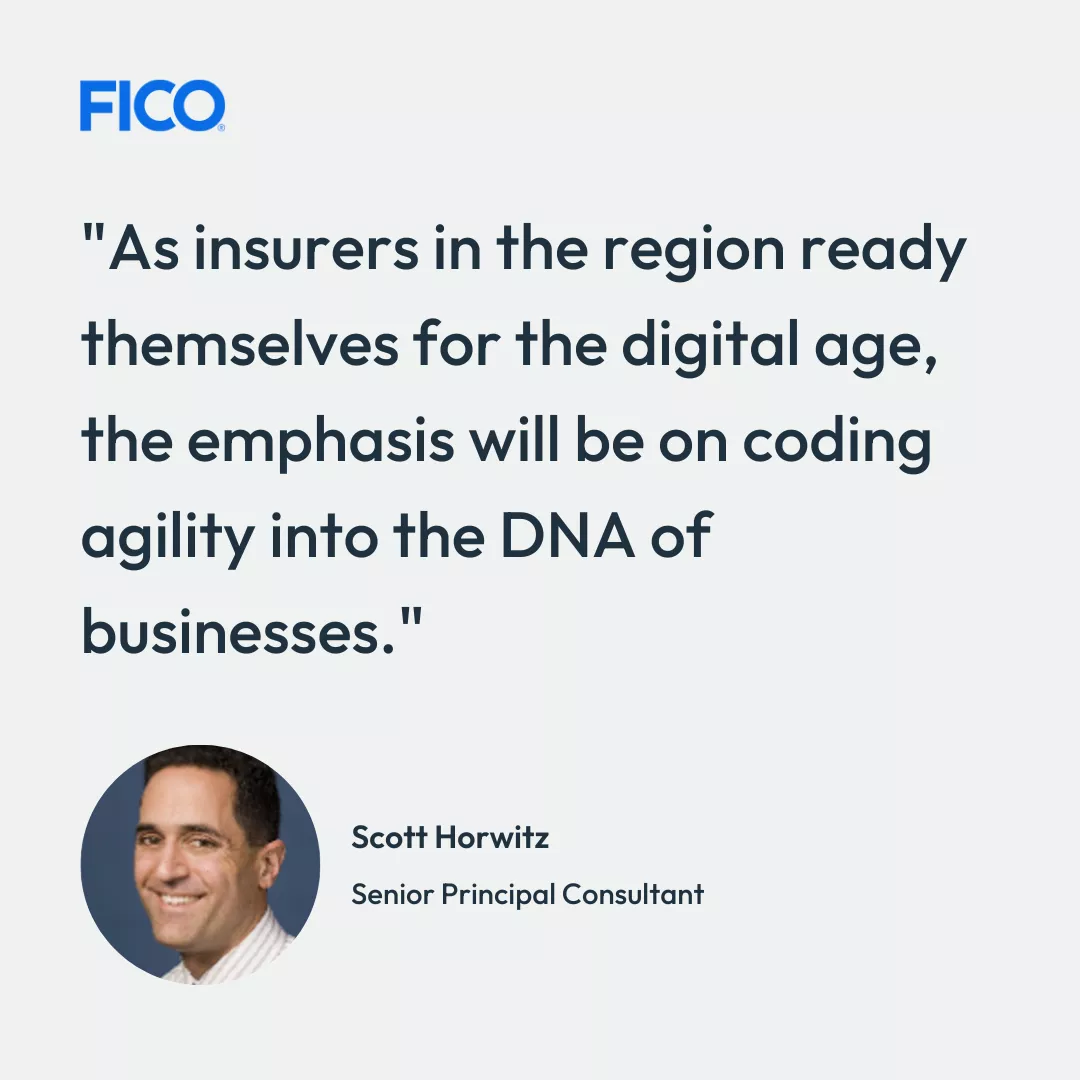For Asia’s Insurance Sector, It’s Digitize or Die
Asia’s insurance sector is at the front line of new era of wealth generation - the winners will be the insurers that have their digital transformation “house" in order

Digital transformation is a high priority for many industries globally, but Asia’s insurance sector will unquestionably be at the front line of adoption in the year ahead.
This is more out of necessity than design, given that a majority of the region’s population will tip into the middle and retirement class for the first time over the next two years.
Whilst this emerging wealth and demographic dividend has elevated Asia to be the sector’s global growth engine over the past decade, the region’s wealth inflection point is arriving at a time of industry upheaval.
Asia’s Rising Wealth Comes with Increased Expectation
Customers across Asia are increasingly expecting more from their insurers. Driven by their own emerging personal circumstances and external uncertainties like extreme weather, pandemics, and technological disruptions, they're looking for insurers that are integrating services that address their home, car, health and financial well-being concerns.
Findings by Accenture highlight that the global insurance industry stands to lose up to $170 billion in premiums in the five years to 2027 due to unsatisfactory claims processes. Moreover, underwriting inefficiencies could further dent the industry by $160 billion. But even beyond that, insurers are being called to move from merely reimbursing losses to actively offering solutions that mitigate risks, reflecting consumer desire for purpose-driven services that include rewards for healthy living.
Customers are increasingly seeking personalized products, especially in life insurance, tailored to their risk tolerance and preferences. Additionally, while Asia has traditionally relied on third-party agents, there's a growing preference for self-directed, digital channels.
Elsewhere, regulatory headwinds are being brought to bear on insurers operating across many markets, with local reforms zeroing in on insurers’ use of artificial intelligence, capital buffers for solvency protection and protection of customer data.

India, Indonesia and Malaysia at the Coalface
The impact of this shake-up is most evident in rapidly developing economies like India, Indonesia and Malaysia. Although each possesses its unique characteristics, their large populations, especially those transitioning into the middle-class segment, position them as prime examples of the ongoing digital and innovation revolution. Moreover, these markets are poised for further advancements in the future.
In India, the Insurance Regulatory and Development Authority’s 'Bima Trinity' blueprint aims for universal insurance coverage by 2047. Key reforms include bundling health, life, property and accident insurance into one policy and using a unified platform for policy transactions. These changes, designed to improve customer access, await parliamentary approval in the second half of 2024.
Malaysia's insurance sector is innovating with “Pay as You Drive” models like MSIG's EZ-Mile, using real-time data for personalized pricing, tackling the underinsurance of 90% of its population. The phased liberalization of the Malaysian Motor Tariff is encouraging collaborations like Policy Street and CARSOME's personal accident coverage, which includes unemployment protection, showcasing a customer-centric approach and readiness for further liberalization.
Indonesia's insurance sector faces transformative regulations, requiring higher capital, influencing product offerings, and revising reinsurance practices by 2028. The Financial Services Authority's (OJK) plan to increase minimum equity requirements may force insurers to seek additional capital or consider mergers and acquisitions to comply.
Asia’s Insurance Sector Is Crossing the Digital Divide
Providing hyper-personalized services, streamlined claims processing, and more accurate underwriting is front and center of customer engagement strategy. To remain competitive or even relevant in these markets and wider, insurers are embracing digital tools, AI, machine learning and blockchain technology.
For instance, India’s Cholamandalam MS General Insurance has introduced AI in motor claims processing, successfully settling 94% of claims through its application. Shriram Life Insurance is leveraging AI and digital technology to cater to the rural market, where a significant portion of its retail premiums originate. Similarly, Star Health and Allied reports that 65% of its cashless claim evaluations are automated.
There's a critical need for industry to embrace and invest in cutting-edge technologies — not just experimentally, but as core elements of their service delivery and operations. Customers have embraced digital platforms and express a preference for managing simple transactions digitally. Yet, there remains a considerable gap in insurers' ability to offer convenient digital tools and services.
This is where FICO can assist with the transition.
FICO’s Solutions Are an Enabler of the Insurance Sector’s Transition
To navigate regulatory and technological changes, FICO Platform enables insurance companies to address key business challenges by augmenting their existing systems, ensuring effective decision intelligence authoring and oversight, and enabling quick, confident, responsible, and low-risk deployment of relevant, robust solutions driven by business users.
Insurers can turn to FICO Platform components like Business Outcome Simulation, which allows business users to create sophisticated simulations of strategy changes related to individuals or portfolios, magnifying risk assessment accuracy and powering more precise decision tailoring with minimal IT support.
Additionally, “always on” services within the FICO Platform have the potential to transform customer engagement by providing timely alerts for policy renewals, identifying potential coverage gaps, and suggesting adjustments based on life events. It can also respond instantly to customer needs in real-time.
Such innovations not only ensure seamless customer experiences but bolster confidence in the insurer's ability to adapt and respond in real-time along the customer’s journey.
The trajectory of Asia's insurance sector is unmistakably towards greater digital integration and innovation.
As insurers in the region ready themselves for the digital age, the emphasis will be on coding agility into the DNA of businesses, customer-focused drive, technical sophistication and confronting regulatory change. The race is on for Asian insurers to embrace these challenges to redefine the insurance landscape, securing prime positions in a competitive market.

Learn How FICO Platform Can Power Your Digital Transformation in Insurance
- Attend the FICO x Insurance Asia News Webinar: Addressing Complexities in Underwriting and Claims
- Read our blog on Digital Transformation and the Future of Insurance
- Read our executive brief on Win-Win: Claims Administration that Results in Positive Policyholder Experiences
- Read our executive brief on “The Retirement Cliff” looms ahead for claims processing
- Watch the video “FICO® Platform: Applied Intelligence, when and where it matters”
- See customers discuss their use of FICO Platform
- Read the case study “Mercury Insurance: Leading insurer “democratizes” its decisioning platform for insurance underwriting”
Popular Posts

Business and IT Alignment is Critical to Your AI Success
These are the five pillars that can unite business and IT goals and convert artificial intelligence into measurable value — fast
Read more
It’s 2021. Do You Know What Your AI Is Doing?
New "State of Responsible AI" report from Corinium and FICO finds that most companies don’t—and are deploying artificial intelligence at significant risk
Read more
FICO® Score 10T Decisively Beats VantageScore 4.0 on Predictability
An analysis by FICO data scientists has found that FICO Score 10T significantly outperforms VantageScore 4.0 in mortgage origination predictive power.
Read moreTake the next step
Connect with FICO for answers to all your product and solution questions. Interested in becoming a business partner? Contact us to learn more. We look forward to hearing from you.
